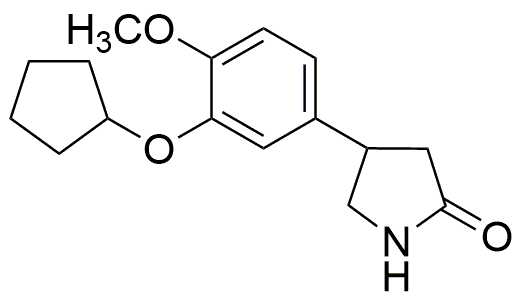Rolipram is widely utilized in research focused on:
- Neuropharmacology: It acts as a selective phosphodiesterase-4 (PDE4) inhibitor, which can enhance cognitive function and has potential applications in treating neurodegenerative diseases like Alzheimer's.
- Anti-inflammatory therapies: By inhibiting PDE4, Rolipram reduces the production of pro-inflammatory cytokines, making it a candidate for developing treatments for chronic inflammatory conditions such as asthma and rheumatoid arthritis.
- Psychiatric disorders: Research indicates its efficacy in improving symptoms of depression and anxiety, providing a new avenue for developing antidepressant medications.
- Cardiovascular health: The compound shows promise in protecting against heart failure by modulating inflammatory responses and improving cardiac function.
- Drug delivery systems: Rolipram can be incorporated into nanocarriers for targeted drug delivery, enhancing the efficacy of therapeutic agents in treating various diseases.
General Information
Properties
Safety and Regulations
Applications
Rolipram is widely utilized in research focused on:
- Neuropharmacology: It acts as a selective phosphodiesterase-4 (PDE4) inhibitor, which can enhance cognitive function and has potential applications in treating neurodegenerative diseases like Alzheimer's.
- Anti-inflammatory therapies: By inhibiting PDE4, Rolipram reduces the production of pro-inflammatory cytokines, making it a candidate for developing treatments for chronic inflammatory conditions such as asthma and rheumatoid arthritis.
- Psychiatric disorders: Research indicates its efficacy in improving symptoms of depression and anxiety, providing a new avenue for developing antidepressant medications.
- Cardiovascular health: The compound shows promise in protecting against heart failure by modulating inflammatory responses and improving cardiac function.
- Drug delivery systems: Rolipram can be incorporated into nanocarriers for targeted drug delivery, enhancing the efficacy of therapeutic agents in treating various diseases.
Documents
Safety Data Sheets (SDS)
The SDS provides comprehensive safety information on handling, storage, and disposal of the product.
Product Specification (PS)
The PS provides a comprehensive breakdown of the product’s properties, including chemical composition, physical state, purity, and storage requirements. It also details acceptable quality ranges and the product's intended applications.
Certificates of Analysis (COA)
Search for Certificates of Analysis (COA) by entering the products Lot Number. Lot and Batch Numbers can be found on a product’s label following the words ‘Lot’ or ‘Batch’.
*Catalog Number
*Lot Number
Certificates Of Origin (COO)
This COO confirms the country where the product was manufactured, and also details the materials and components used in it and whether it is derived from natural, synthetic, or other specific sources. This certificate may be required for customs, trade, and regulatory compliance.
*Catalog Number
*Lot Number
Safety Data Sheets (SDS)
The SDS provides comprehensive safety information on handling, storage, and disposal of the product.
DownloadProduct Specification (PS)
The PS provides a comprehensive breakdown of the product’s properties, including chemical composition, physical state, purity, and storage requirements. It also details acceptable quality ranges and the product's intended applications.
DownloadCertificates of Analysis (COA)
Search for Certificates of Analysis (COA) by entering the products Lot Number. Lot and Batch Numbers can be found on a product’s label following the words ‘Lot’ or ‘Batch’.
*Catalog Number
*Lot Number
Certificates Of Origin (COO)
This COO confirms the country where the product was manufactured, and also details the materials and components used in it and whether it is derived from natural, synthetic, or other specific sources. This certificate may be required for customs, trade, and regulatory compliance.


